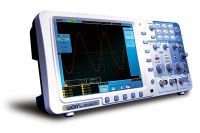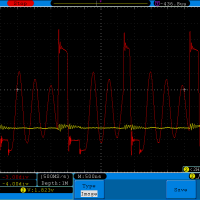Oscilloscope
An oscilloscope is something an embedded software engineer can live without. But as soon as you get to work with real hardware or fancy interfaces this might be a very nice addition to your work bench.
I own a very old scope, a Philips PM3200X; a 15 MHz scope with TV triggering. I bought the scope second hand in 1990 for not too much money. Needless to say this scope is a bit outdated. I replaced the CRT because it had faded away too much but meanwhile both the tube and the high voltage power supply could do with a make over...
Time for something new, preferably a high speed digital scope with an LCD screen and a high sampling frequency.
Brand new or new brand ?
Ever heard of Owon?
Neither had I.
I have ordered from a Dutch webshop, Eleshop, before. They import and sell nice equipment ranging from simple tools up to digital oscilloscopes and logic analyzers for fair prices. I found the to be a reliable supplier: prompt delivery, equipment is as described and everything very well packed. The quality of the equipment is good.
In their catalog I found the Owon scopes and I've just ordered the SDS8202, a dual channel 2 GS/s sampling scope for € 699,- (that is including VAT!) with a 10M sampling buffer. It is unfair to compare this scope against one of the (way more expensive) professional brands. I am using my scope for hobby and occasional professional use so Tektronix or LeCroy is just out of my reach.
Yes, I know they have cheaper models as well, but these just look and feel like a cheap chinese rip-off of the more expensive models - with lesser specs of course...
I surfed on the internet a lot before deciding which scope to buy and I must say that I did find some cheaper models. But I prefer a local shop in favour of a € 150 (without shipping & import duties!) cheaper scope from some webshop that is based in the US or China.
A quick review
First impression is that the box is small, almost too small.
But after unpacking I can only conclude that the display is big, almost too big (no, that's not possible).
The LCD is 16 x 12.5 cm and the waveform is shown on a grid of 15 x 10 cm. The remaining part of the 34 x 15.5 cm large front panel is taken up by the keys and knobs. The function keys next to the screen have rigid keycaps, the other keys are rubber keys like you find on remote controls or calculators but with a nice click that leaves no question about a button being pushed.
The scope also stands firm on its base and on my workbench lies a antistatic sheet keeping the scope from sliding away when any keys are pushed. Lilliput created a very nice series of oscilloscopes there are stable enough to be used in a professional setup and yet the scope is compact and light enough to fit in the portable luggage of a service engineer.
The first impression, even before switching the oscilloscope on, is that this looks as good as the low-cost tektronix scope I have seen before but it surprisingly feels better. The Owon scope feels like a professional one whereas the Tektronix scope from the cheap range feels like a chinese copy ...
Switching on the scope
After switching the scope on the fan in the scope starts humming, but don't worry; you will hardly notice this, and the LCD shows a very clear picture. I could not resist to see what all the buttons do.
I can surely recommend this when you buy one; the functions are mostly self explanatory and where they are not, the
"help" button shown a very readable explanation of all the functions.
Specifications
I will not bother you with a complete list of all specifications. These you can find directly on the Owon website.
All I want to note is that this is a 2 GS/s scope with the samples split over both channels, so if you use 2 channels you effectively have 1 GS/s per channel and there is a 10 Msample buffer available.
First image
After hooking up the scope to the test setup of my new DC/DC converter getting a picture on the LCD is easy. Using a single triggering setup I can capture the behaviour of the FET outputs of the buck converter and see what is going on.
It is easy to determine that this is a 500 kHz signal that has a 180 ns high and a 100 ns low period with a floating FET stage for the remainder of the period. Pushing the "save" button saves the image (800x600) in .bmp format to a memory stick.
The only problem I had is that it did not like my 16 GB memory stick so I had to dig deep down in my bag to get a smaller 4 GB stick.
10 M Samples buffering
I have programmed the scope to acquire1 Msample buffer at a slower speed (500 us/div sound slow when sampling 100 ns pulses) - I could have set it to 10 Msamples but I just wanted to see what happens here.
Again using single shot triggering (now set on Channel 2) to capture the startup behaviour of the DC/DC converter.
This shows that it takes about 6 ms for the converter to generate the full 3.3V output that it should give. This is due to the soft start feature that the IC uses. With this waveform in memory I can now scroll and zoom in to see in more detail what is happening.
10,000,000 samples is a lot - so there is a lot of room for zooming.
Zooming in
There it is! After a x1000 zoom the pulses of the soft-start feature are visible.
Actually I should have zoomed out a bit so it would be clear that the soft start results in a few pulses followed by a period of no pulses etc. until a certain voltage level is reached.
But I could not resist to show how far one can zoom in with a deep sample buffer (and there is even 10 times more if you need)
Other features
I have played around with some of the other features:
- Cursor
to measure the time between two points (and the frequency that 1/t represents) or to measure the voltage range of a signal. - FFT
to convert the measured signal in to a frequency diagram. This shows how the square wave generator outputs a full list of harmonic frequencies. - Direct channel measurements (mean or top voltage)
reduces the need to grab the multimeter for each and every measurement I do. Just stick the probe on th 3.3V output and look at the noise on the power lines and measure the voltage at the same time.
The cursor and FFT measurements are also available when data acquisition is stopped but I am not sure what the channel measurement does at this point. When connected to a fairly stable signal (like the output of the DC/DC converted), the proper voltage is shown but when stopped I see a strange value for the output voltage: it reads 1.823 V in all pictures which is kind of a silly value.
Then there is also a feature to save the measurements as waveform. This results in a binary file that can be read using the oscilloscope software on the PC. I was only able to save 1 waveform per file and can only show 1 waveform at the same time. The examples delivered with the software show 2 waveforms in one file but both waveforms can be zoomed or panned independently, something which is very strange for an oscilloscope application.
being able to export waveforms in binary format could be a nice feature. This means that you can zoom, pan or measure the data offline on a PC. But it needs some more investigation and probably a more advanced application to be usable.
The last feature tested is the PC connection. it is possible to store waveforms and images directly on the PC using a USB or network connection. I am not impressed by this feature - the user interface of the oscilloscope is excelent but the PC software is a bit cryptic and I can hardly wait to write my own software to make this a more usable feature.
Owon website
The manual mentions owon.com.cn as the website for Owon but somehow I eneded up on another site: owon.com.hk which surprisingly contains newew information and the latest software versions. At the moment of writing the oscilloscope is delivered with oscilloscope version 2.0.8.3 which is the latest release available on the webstie.





